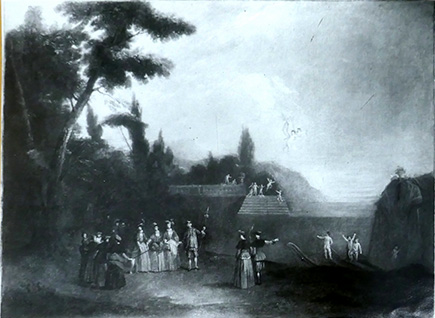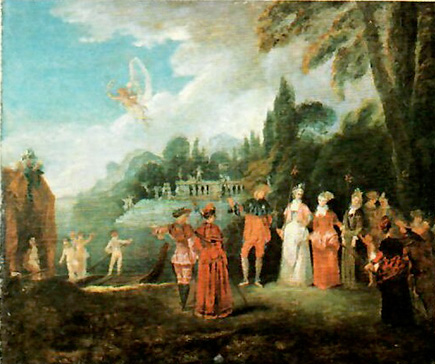
- Home Page
- Accepted
Paintings & Copies - Doubtful
Attributions - Doubtful Textual References
- Alternative
Titles - Collectors &
Museums - Bibliography
- Search Abecedario
- Watteau &
His Circle
L’Ile de Cythère (copy 1)
Entered February 2024
Whereabouts unknown
Oil on canvas
44 x 54 cm
ALTERNATIVE TITLES
L’Ile de Cithere
The Isle of Cythera
RELATED PRINTS
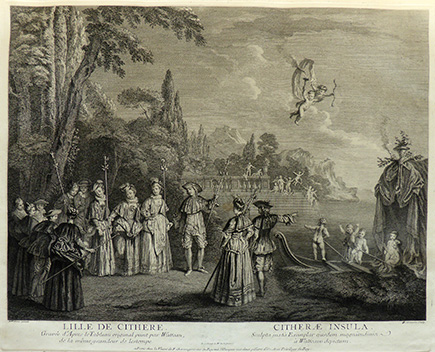
Nicolas de Larmessin after Watteau, L’Ile de Cythère, engraving, 1730.
It is not evident whether Nicolas de Larmessin’s engraving after L’Île de Cythère was executed after Watteau’s autograph version, now in Frankfurt, or after this copy. The caption on the print indicates that the painting was in the "Cabinet de Mr de Jullienne" and was "de la meme grandeur de lestempe [sic]." However, although the print measures 33.2 x 44.1 cm, both paintings are larger than the print: the Frankfurt painting is 43.1 x 53.3 cm, and this copy is 46.5 x 56 cm.
PROVENANCE
Perhaps Paris, collection of Jean de Julienne. His ownership is indicated in the caption of Larmessin’s 1730 print: "Cabinet de Mr de Jullienne." Jullienne apparently sold the painting prior to the preparation of the 1756 illustrated catalogue of his collection, a manuscript now in the Morgan Library & Museum, New York.
Frankfurt, collection of count Pelat (or Pélas).
Paris, collection of Simon Jacques Rochard (1788-1872; portrait miniaturist). His sale, Paris, December 13, 1858, lot 64: “WATTEAU (ANTOINE) . . . L’Ile de Cythère. (Gravé—Tiré du cabinet du comte Pelat, de Francfort.).”
Paris, collection of Simon Jacques Rochard. His sale, Paris, Hôtel Drouot, December 13-14, 1866, lot 153: "[WATTEAU (ANTOINE) . . . L’iIle de Cythère. Des amoureux, sous des habits de fête, se disposent à s’embarquer dans un bateau pavoisé que dirigent des amours; charmant paysage, parc et terasse, ciel léger. Sujet gravé. (Collection Pélas, de Francfurt.) Toile. Haut . 48 cent.; larg. 35 cent.”
Paris, Masson collection. His sale, Paris, February 1, 1875, lot 73, Watteau, L’Embarquement pour Cythère, oil on canvas, 45 x 55 cm, engraved.
Paris, sale, May 1, 1876.
Twickenham, collection of Henry G. Bohn. His sale, London, March 19, 1885, lot 64: “A. WATTEAU . . . THE ISLAND OF CYTHERA / 18 in by 22 in.” According to an annotated sale catalogue in the Rijksbureau voor Kunsthistorische Dokumentatie, the painting sold for £136.10 to Wertheimer.
London, with Samson Wertheimer (c. 1811-1892; art dealer) or his son Asher Wertheimer (1843-1918; art dealer).
Paris, collection of Henri Michel-Lévy (1844-1914; artist). Sold to Sedelmeyer in 1898.
Paris, with Galerie Sedelmeyer. The firm’s red paper label was still on the back of the canvas in 1988.
Paris, with Fischkof, acquired on June 14, 1901. Sold in 1902 to Henri Heughel.
Paris, collection of Henri and Rose (née Creed) Heughel. By descent to Jacques Heughel (1890-1979).
Paris, with the Galerie de la Scala.
New York, sale, Sotheby’s, May 16, 1996, lot 98: “Attributed to Jean Antoine Watteau . . .THE ISLE OF CYTHERA / oil on canvas 17¾ x 21¾ in. 45.1 x 55.2 cm / The primary version by Watteau of the present composition, datable to circa 1709-10, is in the Städtische Galerie in Städelschen Kunstinstitut, Frankfurt. Watteau returned to the theme again, on a larger scale, in his Pilgrimage to the Island of Cythera of 1717, now in the Musée du Louvre, and his 1718 version of similar subject. . .
Provenance: / Jean de Jullienne, until 1756 / Probably Count Pelaz, Frankfurt (Sale: 1793) / M.R. (Sale: Paris, December 13, 1858, lot 64) / Rochard (Sale: Paris, December 13, 1866, lot 153) / Mason (Sale, Paris, February 1, 1875, lot 73) / Sale: Paris, May 1, 1876 / G. Bohn (Sale: London, March 19, 1885, lot 65) / Wertheimer / Michel-Levy / Sedelmeyer, acquired on June 30, 1898 / Fischkof, acquired on June 14, 1901 / Sedelmeyer, 1902 / H. Heughel, Paris, since 1902. . .”
EXHIBITIONS
Paris, Galerie Sedelmeyer, 100 Paintings by Old Masters (1899-1901), cat. 84 (as by Watteau, L'Île de Cythère).
London, Guildhall, Exhibition of Examples of French and English Painters (1902), cat. 112 (as by Watteau, L'Île de Cythère (The Isle of Cythera), lent by Charles Sedelmeyer).
Paris, Galerie Jacques Heughel, De Watteau à Cezanne [n.d.], cat. 67.
Paris, Galerie Charpentier, Danse et divertissements (1949), cat. 235 (as by Watteau, Premier projet de l’embarquement pour Cythère).
Geneva, Musée d’art, De Watteau à Cezanne, cat. 67 (as by Watteau, L’Embarquement pour Cythère, lent by a private collector).
Brussels, De Watteau à David, (1975), cat. 44 (as by Antoine Watteau, L’Ile de Cythère, lent by the Heughel collection)
Paris, Galerie Cailleux, Des Monts et des eaux (1980), cat. 44 (as Antoine Watteau, L’Ile de Cythère, lent by the Heughel collection).
SELECT BIBLIOGRAPHY
Hédouin, “Watteau” (1845), cat. 93.
Hédouin, Mosaïque (1856), cat. 94.
Goncourt, Catalogue raisonné (1875), cat. 140.
Staley, Watteau (1902), 33, 150.
Zimmermann, Watteau (1912), pl. 29, 176.
Dacier, Vuaflart, and Hérold, Jean de Jullienne et les graveurs, (1921-29), 3: under cat. 155.
Hildebrandt, Watteau (1922), 103-04.
Réau, “Watteau” (1928), cat. 153.
Gillet, La Peinture au Musée du Louvre (1929), 38.
Adhémar, Watteau (1950), under cat. 33.
Mathey, Watteau, peintures réapparues (1959), 67.
Levey, “Watteau’s Embarkation for Cythera" (1961), 182.
Macchia and Montagni, L’opera completa di Watteau (1968), cat. 14.
Ferré, Watteau (1972), cat. A 3.
Tomlinson, La Fête galante (1981), 131-32.
Frankfurt, Städelsche Kunstinstitut, Einschiffung nach Cythera (1982).
New York, Segoura Gallery, From Watteau to David (1982), 9-16.
Duret-Robert, “Un Bernin pour mille Francs” (1982), 117-22.
Duret-Robert, “Qui décide de l’authenticité des tableaux?” (1986), 28-29.
Börsch-Supan, Antoine Watteaus Embarquement (1983), 21.
Washington, Paris, Berlin, Watteau 1684-1721 (1984), under cat. 9.
REMARKS
Throughout the nineteenth and twentieth centuries, this version of L’Île de Cythère was universally accepted as the original from Watteau’s hand. The situation changed radically in 1977, after the autograph version of the painting was discovered in England, in the collection of Major General Edward Henry Goulburn. Since then, the ex-Goulburn picture has found universal acceptance and the ex-Heughel version has been unanimously rejected as a copy.
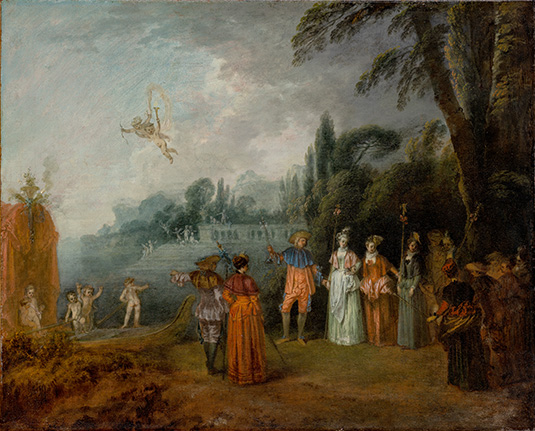
Watteau, L’Îlle de Cythère, 45.5 x 56 cm. Frankfurt, Städel Museum
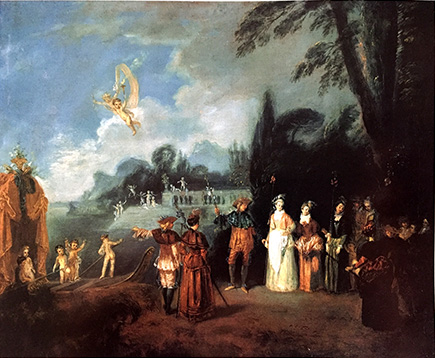
Unidentified French artist after Watteau, L’ÎIle de Cythère, oil on canvas, 44 x 54 cm. Whereabouts unknown.
As discussed apropos of the Frankfurt painting, there is overwhelming visual evidence that that painting is the autograph version. To reaffirm this and demonstrate that the Heughel version is an inferior copy, we might consider just a single figure: the putto standing on the row of the ship. In the Frankfurt version, a slight pentimento—the mark of an autograph work—is visible in the placement of her leg and her fleshy body exudes a certain charm, especially her colorfully accented buttocks. Her face is cast in a delicate profil perdu. The corresponding putto in the Heughel copy lacks these attributes. The outlines are harsh, her profile view is pedestrian, the accents less meaningful, her coiffure is less precise. These small details tell all we need to know about separating the original from the copy.
Important questions about the ex-Heughel painting concern the identity of its artist and the circumstances under which it was created. It is evident that the ex-Heughel painting is a copy made directly from the Frankfurt picture. They are approximately the same size: the Frankfurt picture measures 45.5 x 56 cm while the ex-Heughel canvas is 44 x 54 cm. More telling, the colors—as in the clothing worn by the pilgrims—are essentially the same; such information is not easily transmitted by a drawing or print. The direct dependence on the original Watteau suggests that the copy may have been executed in Watteau’s studio or in Jullienne’s residence.
A much more difficult question is the identity of the artist responsible for the Heughel version. Scholars might want to name Watteau’s assistant, Jean-Baptiste Pater. Alternatively, they might propose Philippe Mercier, especially because he engraved the Frankfurt painting. But the ex-Heughel painting has no traits of either Pater’s or Mercier’s touch. By contrast, when Pater copied Watteau’s compositions, as in his rendering of Watteau’s Plaisirs du bal now in the Wallace Collection, Pater’s distinctive sketchy brushwork and facial features are readily visible. Who, then, was the copyist responsible for the Heughel version? Was he some unnamed assistant in Watteau’s elusive shop or was he a professional copyist employed by Jullienne? This is an intriguing issue, with important implications for both Watteau and Jullienne.
L’Ile de Cythère (copy 2)
Entered February 2024
Whereabouts unknown
Oil on canvas (presumed)
Measurements unknown
PROVENANCE
Venice, Fiorentini collection.
REMARKS
This painting is known to me through a photograph in the Getty Research Institute. The verso of the photo indicates that the picture was attributed to an anonymous eighteenth-century artist. The direction of the composition shows that it was based on one of the engravings after Watteau’s picture, undoubtedly the one by Larmessin that was more widely available. That this copy is based on an established Watteau composition but with the figures spaced out across a wide landscape suggests analogies with several other copies after Watteau. Some of these works have an English provenance, which suggests the paintings’ possible origins.
L’Ile de Cythère (copy 3)
Entered February 2024

Whereabouts unknown
Medium unknown
43.2 x 45.7 cm
ALTERNATIVE TITLES
L’Embarquement de Cythère
PROVENANCE
Paris, sale, collections of Jean Fréderic Guillaume d’Amarzit de Sahuquet, comte d'Espagnac, and Tricot, May 22f., 1793, lot 100 bis: “Par le méme [Ant. Watteau]. Un tableau de Watteau, composition de plusieurs figures et paysage, représentant l’embarquement de Cythère. Haut. 17 pouces, larg. 18 pouc.” According to an annotated sale catalogue in the Frick Art Reference Library, the picture sold for 50 livres.
SELECT BIBLIOGRAPHY
Dacier, Vuaflart, and Hérold, Jean de Jullienne et les graveurs (1921-29), 3: under cat. 110.
REMARKS
The relatively small size of this picture corresponds to that of L'Île de Cythère and its copies, and separates it from the substantially larger size of the Louvre and Berlin versions of the Pèlerinage à Cythère and their copies.
L’Île de Cythère (copy 4)
Entered February 2024

Whereabouts unknown
Medium unknown
66 x 42 cm (more probably 42 x 66 cm)
ALTERNATIVE TITLES
Le Départ pour Cythère
Voyage à Cythère
PROVENANCE
Paris, Duclos-Dufresnoy collection. His sale, September 1795 [fructidor an III], lot 24: 66 x 42 cm, esquisse.
Paris, sale, March 28, 1831, lot 94: Voyage à Cythère, le première pensée du maître.
Paris, Leuiller collection. His sale, Paris, January 10, 1834, lot 111: Le Départ pour Cythère, esquisse.
SELECT BIBLIOGRAPHY
Dacier, Vuaflart, and Hérold, Jean de Jullienne et les graveurs (1921-29), 3: under cat. 110.
REMARKS
Our reading of these three references as pertaining to a single painting is tentative since so little data is given at each appearance. The first mention is useful because it gives measurements which though probably reversed, accord with L'Île de Cythère rather than the larger versions in Paris and Berlin. Significantly, both the 1795 and 1834 sales describes the work as an “esquisse.” That all three paintings came to auction within a relatively short period is yet another indication that they may all refer to one work.
L'Île de Cythère (copy 5)
Entered February 2024
Bilboa, Museo de Bellas Artes de Bilboa
Oil on canvas
45 x 54 cm
PROVENANCE
Collection of Laureano Jado (1843-1926; engineer and philanthropist). Bequeathed to the Bilbao museum.
EXHIBTIONS
Paris, Musée de la Monnaie, Pèlerinage à Watteau (1977), cat. 172 (as by the French School, 18th century, L’Île de Cythère).
SELECT BIBLIOGRAPHY
Washington, Paris, Berlin, Watteau, 1684-1721 (1984), under cat. 9.
REMARKS
This painting follows the direction and color scheme of the ex-Heughel picture. Although included in the catalogue for the 1977 exhibition, it was not on view there.
Click here for L'Île de Cythère
